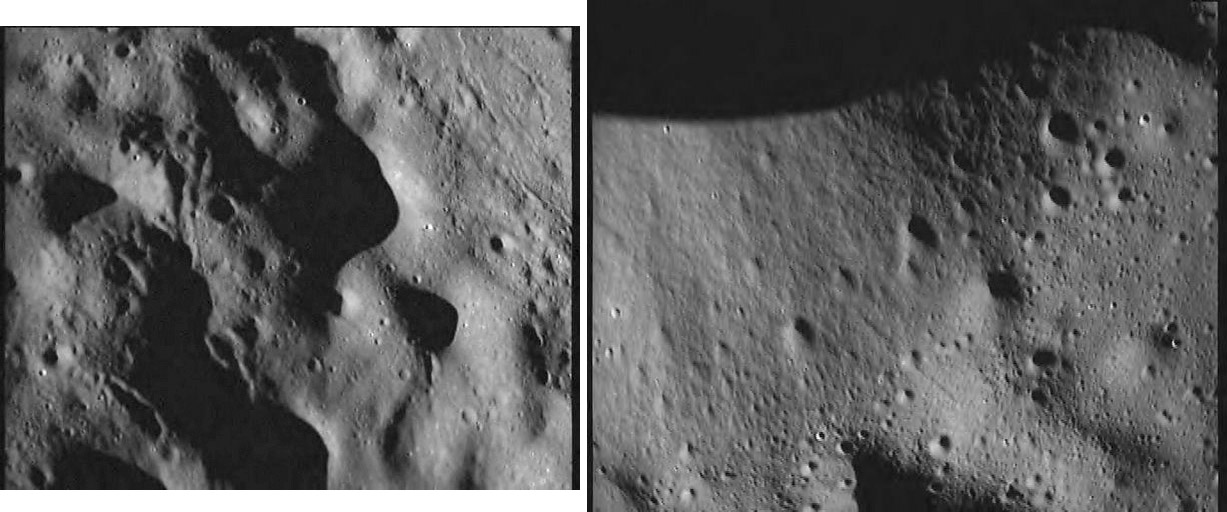Difference between revisions of "March 31, 2018"
| Line 7: | Line 7: | ||
<em>Chandrayaan MIP images from [http://www.universetoday.com/2008/11/14/moon-impact-probe-hits-paydirt-or-pay-regolith Universe Today]</em><br /> | <em>Chandrayaan MIP images from [http://www.universetoday.com/2008/11/14/moon-impact-probe-hits-paydirt-or-pay-regolith Universe Today]</em><br /> | ||
<br /> | <br /> | ||
| − | Not since [http://nssdc.gsfc.nasa.gov/imgcat/html/mission_page/EM_Ranger_9_page1.html Ranger 9] in 1965 has a probe crash-landed into the Moon with cameras clicking all the way down. Until yesterday. India's Chandrayaan-1 satellite, which recently achieved lunar orbit, released a small Moon Impact Probe (MIP) which spent 25 minutes diving towards the surface before reaching its target, reportedly inside Shackleton crater. These two images from the sequence - what a movie it will make! - appear to be from near the end. I assume that the leftmost view is from a greater distance than the right image because the pervasively pitted right image is characteristic of extreme close-ups of the lunar surface. It appears that the rim of a crater passes from upper right through the middle to lower left, with the less stable crater rim (upper left) having fewer pits than the exterior (lower right). Both images contain short lines of pits, which could be eroded secondary crater chains or [https://the-moon.us/wiki/ | + | Not since [http://nssdc.gsfc.nasa.gov/imgcat/html/mission_page/EM_Ranger_9_page1.html Ranger 9] in 1965 has a probe crash-landed into the Moon with cameras clicking all the way down. Until yesterday. India's Chandrayaan-1 satellite, which recently achieved lunar orbit, released a small Moon Impact Probe (MIP) which spent 25 minutes diving towards the surface before reaching its target, reportedly inside Shackleton crater. These two images from the sequence - what a movie it will make! - appear to be from near the end. I assume that the leftmost view is from a greater distance than the right image because the pervasively pitted right image is characteristic of extreme close-ups of the lunar surface. It appears that the rim of a crater passes from upper right through the middle to lower left, with the less stable crater rim (upper left) having fewer pits than the exterior (lower right). Both images contain short lines of pits, which could be eroded secondary crater chains or [https://the-moon.us/wiki/Boulder_Tracks boulder tracks]. The high quality of these images, and the total success of the mission so far, give hope that Chandrayaan-1 will be a major contribution to lunar science. And the quick release of these images suggests that the world will be able to share India's discoveries as they occur!<br /> |
<br /> | <br /> | ||
<em>[mailto:tychocrater@yahoo.com Chuck Wood]</em><br /> | <em>[mailto:tychocrater@yahoo.com Chuck Wood]</em><br /> | ||
Latest revision as of 17:52, 13 October 2018
Indian Close-Up
Originally published November 15, 2008

Chandrayaan MIP images from Universe Today
Not since Ranger 9 in 1965 has a probe crash-landed into the Moon with cameras clicking all the way down. Until yesterday. India's Chandrayaan-1 satellite, which recently achieved lunar orbit, released a small Moon Impact Probe (MIP) which spent 25 minutes diving towards the surface before reaching its target, reportedly inside Shackleton crater. These two images from the sequence - what a movie it will make! - appear to be from near the end. I assume that the leftmost view is from a greater distance than the right image because the pervasively pitted right image is characteristic of extreme close-ups of the lunar surface. It appears that the rim of a crater passes from upper right through the middle to lower left, with the less stable crater rim (upper left) having fewer pits than the exterior (lower right). Both images contain short lines of pits, which could be eroded secondary crater chains or boulder tracks. The high quality of these images, and the total success of the mission so far, give hope that Chandrayaan-1 will be a major contribution to lunar science. And the quick release of these images suggests that the world will be able to share India's discoveries as they occur!
Chuck Wood
Technical Details
Almost none available yet
Related Links
Chandrayaan team over Moon.
Yesterday's LPOD: Platoization
Tomorrow's LPOD: Moonview 2.0
COMMENTS?
Register, Log in, and join in the comments.



